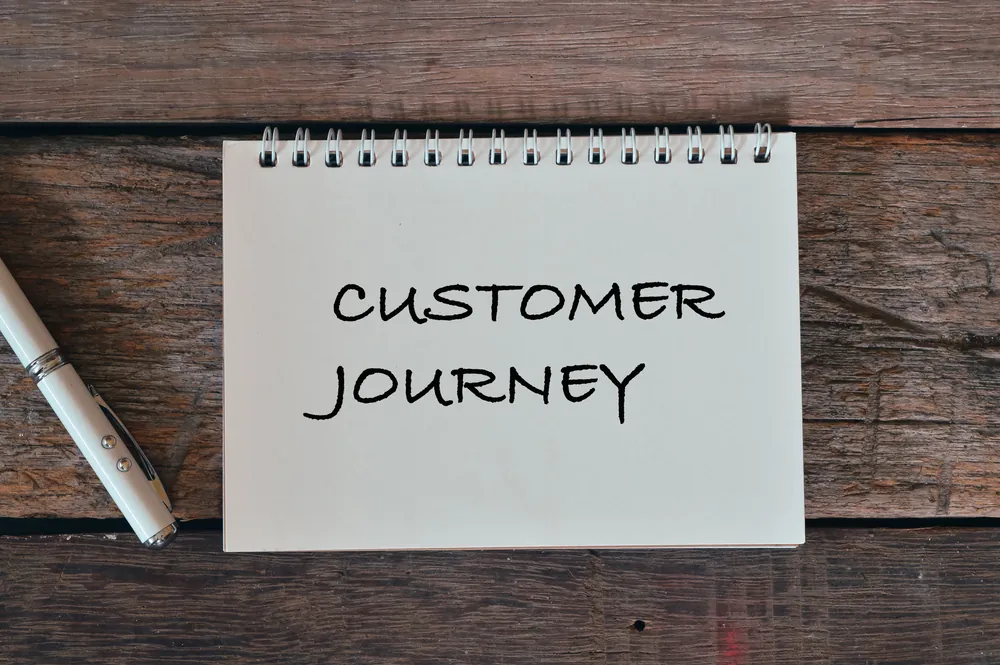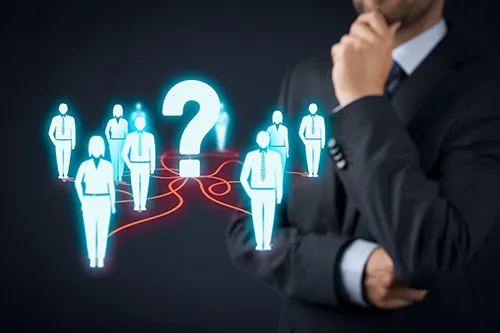A Deep Dive into the Customer Buying Journey

In the preinternet age of sales, the “buyer’s journey” described the four main stages a customer would undergo. It began with awareness (A) about the good or service, then the objective of the salesperson would be to spark interest (I), build desire (D), and eventually, close the deal with an action (A).
This relatively straightforward process—acronymed AIDA—was controlled by salespeople.
They were, in a sense, the drivers of sales.
But the infusion of technology in every aspect of modern life has shifted that paradigm, pushing the modern consumer out of the passenger seat and putting them behind the wheel. This left many companies wondering how to build a sales strategy that is calculated and effective.
Being able to understand and interpret the customer buying journey is still a critical selling skill for sales and marketing teams to know and master. But it’s evolved. To take advantage of it, you must adapt as well.
Here’s how.

What Did The Traditional Buyer’s Journey Look Like?
At one point in time, the buyer’s journey was relatively ubiquitous across industries. Customers entered the top of the sales funnel as a prospect and exited the bottom as a new customer.
E. St. Elmo Lewis first developed the AIDA model in 1898 to illustrate how the act of selling functions.1 It laid out a series of steps a salesperson must guide a potential customer through in order to convert. The stages were:
- Awareness Stage – Building brand awareness around or familiarity with a product or service
- Interest Stage – Drumming up interest about the potential benefits of the product or service—enough so that the buyer starts to conduct research
- Desire Stage – Creating an emotional connection between the buyer and the product or service so that interest evolves into desire
- Action Stage – Driving the final decision around the product or service, whether that’s making a purchase or closing a deal
AIDA was a useful way to tap into buyer psychology. To speak to its success, this linear hierarchy of sales remained in common use for more than a century. And although aspects of AIDA are still relevant today, the buying process has become far more complex.
This is largely due to the evolution of the modern consumer.
The Buyer Has Changed
In the past, salespeople controlled the buyer’s journey. Today, it’s the buyers who are in control.
Why is that?
The emergence of eCommerce has fundamentally changed consumers’ purchasing behavior. We’re currently in the Information Age. Given the technology at our disposal and the wealth of knowledge we can call upon through a search engine, digitization has empowered the buyer.
According to Forrester,2 “In a recent survey, 74% of business buyers told us they conduct more than half of their research online before making an offline purchase. This buyer dynamic changes the role of B2B marketing in a fundamental way. Marketing now owns a much bigger piece of the lead-to-revenue cycle.”
Put simply, modern customers—both individuals and businesses—will conduct their own research to determine what product or service is best for them. This may include digital research, social media channels, and peer discussion. To that end, it will often preclude any type of interaction with a salesperson.
In fact, further Forrester research illustrates how self-directed buyers have become:3
- 60% prefer not to interact with a sales rep as the primary source of information
- 68% prefer to research on their own, online
- 62% say they can now develop selection criteria or finalize a vendor list based solely on digital content
For B2B markets, selling becomes even more difficult as more than half of purchasing decisions involve a group of people—with that percentage increasing the larger and more complex the business becomes.4
How Has This Changed The Customer Buying Journey?
The original buyer’s journey was linear.
The current model has more steps and much more back and forth. Some compare it to a cyclone or funnel, where the buyer may circle around the various phases as they conduct their research. To highlight this phenomenon, today’s customer buying journey stages include:
- Preawareness – There are likely prospects who have no idea you exist. Despite this, they have a pain point you can remedy—something your product or service is built around. Allow this problem to act as the trigger to transition them deeper into the sales funnel. Identify and highlight specific challenges that your product or service directly addresses. Then, push compelling messages that speak to those pain points.
- Awareness Stage – At this point, people are aware of the specific problem and are planning to look into solutions. Often, this begins with a conversation among peers, which is then followed by some initial online research. In this stage, sellers need to work hand-in-glove with the marketing team. Identify your target buyer demographics and work backwards to understand what channels they’re on and what will be most effective—i.e., social media, email, blog content, etc.
- Education Stage – Here, prospects are proactively looking for new solutions (services or products) that they hadn’t previously considered or known about. This involves a deeper dive into what a company might offer. Produce content that speaks to your expertise in your field or industry. At this stage, building trust between your brand and the customer is critical.
- Consideration Stage – After the buyer has educated themself on both the issue and the solutions, they begin to whittle down their potential choices to a select few. From there, they will conduct further research as they consider the best solution. This is an area where you can focus on guidance. Treat this phase as an opportunity to distinguish your product or service from the others, whether that’s through price, efficacy, specific capabilities, or how comprehensive your solution is.
- Rationalization Stage – At this point, a potential buyer is emotionally invested but needs to rationalize their decision about selecting your offering. Expect to receive much more pointed questions about anything from ROI to payment terms. It’s your opportunity to close the deal by resolving all of these.
- Decision Stage – After the decision has been made, there’s still work to be done. Depending on the product or service, there may be fine points that need hammering out. Remember, the deal’s not closed until they signed on the dotted line. Stay diligent with your communication. Don’t pester these buyers; rather, check in periodically to ensure they’re reassured about their decision.
- Ongoing Delivery Stage – Once the sale is made, the journey isn’t over. The most valuable customers are your current ones. Your goal at this stage is to nurture a relationship so that a one-off consumer becomes a loyal customer and active advocate. This stage is unending. Going forward, your job is to maintain a relationship and perform white space analysis to identify opportunities to cross-sell or upsell a product.
How Can You Align Your Sales Process With the Buyer’s Journey?
The world of B2B and B2C sales has evolved. So, how can sellers and sales managers adapt to this shift?
For starters, you can begin by creating a customer journey map, which according to Harvard Business Review, includes:5
“A diagram that illustrates the steps your customer(s) go through in engaging with your company, whether it be a product, an online experience, retail experience, or a service, or any combination. The more touchpoints you have, the more complicated—but necessary—such a map becomes.”
To chart your own map, you must look inward and answer the who, what, where, why, and when of your customers’ buying journey. If you also build a buyer persona or ideal customer profile, you can segment your different audiences to extrapolate how they make purchases. From there, you can optimize certain inputs according to their behavior.
However, this isn’t something that should be siloed to your sales team.
It needs to be a joint effort with your marketing department since they play a fundamental role in the early stages of the buying journey. Together, you can calibrate your marketing and sales messaging to resonate and then map content according to that buyer’s journey.
As you conduct this process, consider the following tips:
- Leverage data from past customers to understand how to refine sales approaches
- Engage in a range of digital marketing strategies, including:
- High-quality content marketing
- SEO
- Paid-ad
- Influencer marketing
- For the early phases, sales teams can provide highly relevant educational resources like:
- Industry reports
- Product comparison guides
- Case studies
- Cost calculators
- Datasheets
- Product or service FAQs
- When it comes to closing, remember that every buyer’s journey is unique. Focus on the specific individual buyer’s needs, pain points, and goals to tailor your messaging.
- Use analytics to track every cycle and measure the efficacy of your current plan.
- Apply the right digital tools to assist with each buying stage.
Your Sales Team Training Solution
The buyer’s journey has changed, and it will only continue to evolve. Sellers and sales managers must be light on their feet and quick to shift with the tides. By taking a responsive position, you can align your efforts to the modern buying journey.
Need more help with that?
We have the solutions your sales team needs. Together, we can implement proven sales training and sales consulting solutions bespoke to your industry and customer.
Sources :
- Oxford Reference. AIDA. https://www.oxfordreference.com/view/10.1093/oi/authority.20110803095432783
- Forrester. B2b Buyer Journey Map Basics. https://go.forrester.com/blogs/15-05-25-b2b_buyer_journey_map_basics/
- Forrester. The Ways And Means Of B2B Buyer Journey Maps: We’re Going Deep at Forrester’s B2B Forum. https://go.forrester.com/blogs/the-ways-and-means-of-b2b-buyer-journey-maps-were-going-deep-at-forresters-b2b-forum/
- DemandGenReport. Revisit Your Messaging Strategy For The New Buyer’s Journey. https://www.demandgenreport.com/blog/a/revisit-your-messaging-strategy-for-the-new-buyer-s-journey/
- Harvard Business Review. Using Customer Journey Maps to Improve Customer Experience. https://hbr.org/2010/11/using-customer-journey-maps-to

- Account Planning (11)
- Awards (49)
- Client Testimonial (37)
- Personal Branding (19)
- Podcast (11)
- Research (70)
- Sales Career Development (87)
- Sales Coaching (156)
- Sales Consulting (137)
- Sales Culture (170)
- Sales Enablement (354)
- Sales Leadership (109)
- Sales Management (248)
- Sales Negotiation (16)
- Sales Prospecting (125)
- Sales Role-Playing (18)
- Sales Training (235)
- Selling Strategies (263)
- Soft Skills (70)
- Talent Management (94)
- Trusted Advisor (27)
- Virtual Selling (49)
- Webinar (9)


























